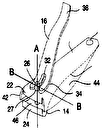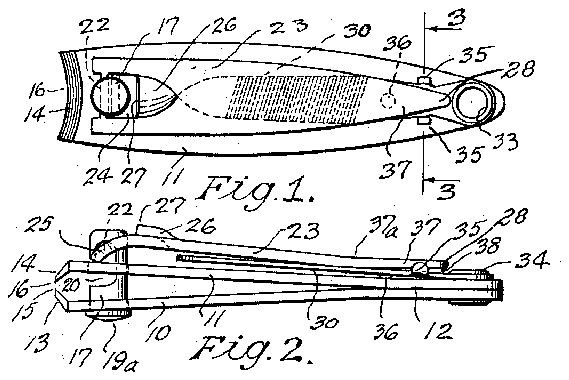
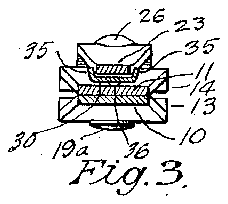

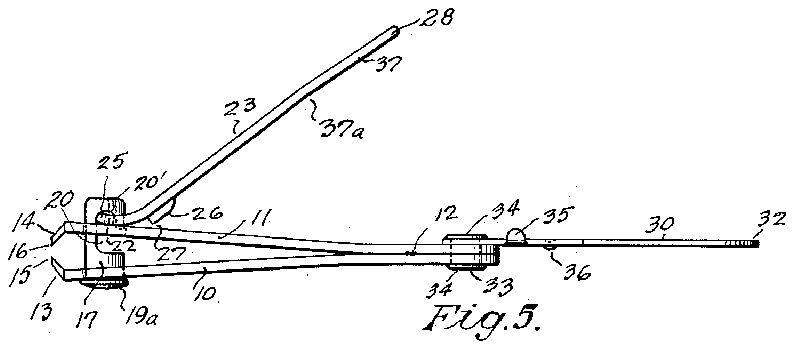
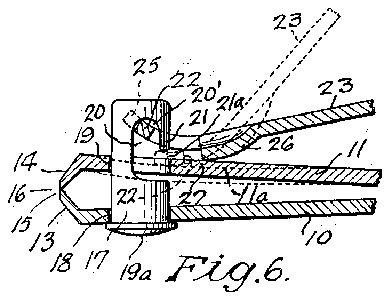
- 3file
- 4i
- 15curved cutting or knife edges
- 18aligned openings
- 20slot
- 22bar
- 23lever
- 24opening
- 26lug
- 28free end
- 30nail file
- 31portion
- 32free end
- 34form securing flanges
- 35upwardly extending lugs
- 39nail file
- 538t united states patents number name date
- 624bassett
- 664bassett
- 995t united states patents number name date
Description
Jan. 5, I954 w. E. BASSETT 2,664,624
NAIL CLIPPER Filed July 5, 1950 Zhwemor M @m (Ittornegs Patented Jan. 5, 1954 UNITED STATES PATENT OFFICE NAIL CLIPPER William E. Bassett, Woodbridge, Conn.
Application July 5, 1950, Serial No. 172,077
4 Claims.
This invention relates to nail clippers and the like, particularly to that type of nail clippers in which a pair of flexible jaw members are secured together at one end and have cutting jaws at the other end normally held open by the resilience of the jaw members, and the invention is especially intended as an improvement over the clipper shown in my Patent No. 2,477,782, granted August 2, 1949.
In this form of clipper, a cam lever is operatively connected to the jaw members by having a cross bar on the end of the lever extend through an undercut slot in a pivot pin extending loosely through the jaw members. The resilient pressure of the jaw members which causes them to normally spread apart also presses the cross bar into the undercut portion of the slot to retain the lever in operative position to manipulate the clipper.
A disadvantage of this construction as heretofore made results from the fact that merely pressing the jaw members together enough to cause the jaws to engage sometimes produces such relative movement between the undercut lever-retaining slot and the lever-engaging jaw member as to open the slot sufficiently to allow the lever to be slipped out of the slot unintentionally by the user. When this occurs the user generally thinks the clipper is broken and returns the separated parts to the factory for repair, whereas all that is needed is to slip the cross bar on the end, of thelever back into the slot in the pivot pin while pressing the jaws together.
An object of this invention is to providea nail clipper of the above type constructed and arranged to positively retain the operating lever against accidental removal without destroying the facility with which the parts can be assembled during manufacture.
A further object is to provide a nail clipper having a lever and pin assembly which can be assembled and disassembled only by applying a flexing stress to the associated jaw members which is greater than any produced in normal operation, so that in normal use the lever will always be retained in operative association with the clipper.
A further object is to provide a nail clipper having a folding nail file movable from inoperative to operative position having an improved arrangement for retaining the file in inoperative position.
With the foregoing and other objects in view, I have devised the construction illustrated in the accompanying drawing forming a part of this specification. It is, however, to be'understood the invention is not limited to the specific details of construction and arrangement shown, but may transverse undercut rec ss 01 n tc 20 p n 2 embody various changes and modifications within the scope of the invention.
In this drawing:
Fig. 1 is a plan view of a nail clipper constructed in accordance with one embodiment of the invention;
Fig. 2 is a side elevation of the clipper shown in Fig. 1;
Fig. 3 is a transverse section on the line 3-3 of Fig. 1;
Fig. 4 is a view similar to Fig. 1 but showing the operating lever extended and illustrating a nail file attachment embodying one of the features of the invention;
Fig. 5 is a side elevation showing the operating cam lever in jaw operating position and the nail file extended, and
Fig. 6 is a partial longitudinal section on an enlarged scale through the cutting jaws and the cam lever and pin assembly illustrating the manner of retaining the lever in operative association with the jaws against accidental disassembly while permitting easy assembly and disassembly thereof when intended, as indicated in broken lines.
This improved clipper comprises two superimposed cutter jaw members Ill and H which are preferably stamped from sheet metal of fairly heavy gauge of any desired shape, but preferably of the substantiallyoblong shape shown, and which are secured in superimposed relation at one end portion by any suitable means, such, for example, as spot welding l2. These members are provided at their opposite ends with cutter jaws l3 and I 4, the free edge portions of which are provided with curved cutting or knife edges 15 and I6 opposed to each other so that when forced together on opposite sides of a finger nail, toenail, or the like, they will trim it to the curved shape of these cutting edges, the free ends of the jaws-being preferably offset from the members I0, II and inclined toward each other somewhat, as shown in Figs. 2, 5 and 6, whereby those portions of the members ill, II adjacent the jaws l3, M are spaced apart. These jaws l3, 14 are normally held open, as shown in Figs. 2 and 5, and this may be done by various means, but preferably either one or both of the members It! and H are spring members, or made of resilient metal, which tend to assume this position.
The means for operating these jaws and their cutting or knife edges comprises a pin I! extending through aligned openings 18 and [9 in the jaws, with its head l9a on the under side of the lower jaw and its shank extending through the upper jaw to a distance above this jaw, this shank being provided in one side with a curved through a side of the pin providing at its top an inverted curved hook portion in which is seated a transverse bar 22 at the end of an operating lever 23. This bar is provided by cutting an opening 24 in this lever spaced a suitable distance back from the adjacent end, and this end of the lever is bent downwardly, as shown at in Fig. 2, to' rest against the top of the upper jaw member II, so that the spring action of the jaws will tend to swing the free end of the lever 23 downwardly against the top of the upper jaw member out of the way into the irioperative position, this action being secured by the lever action on the ends of the curved portion 25, and the bar 22 seating in the end of the notch 20 in the pivot pin. The lever is also provided with an upwardly pressed lug 26 a short distance from the pin H, the end 21 of which when the lever is reversed may rest on the top of the upper jaw member II for operation of the cutter in the clipping operation, see Fig. 5. In moving this device to this position, the lever is raised from the position of Figs. 1 and 2 about its pivot bar 22 to the position of Fig. 4 and then is swung in a circle about the pin IV, the pin during this movement turning in the jaws as a pivot for the lever to permit the lever to be swung to the position of Fig. 5 over the upper bar I I in which position it is reversed or turned over from the position of Figs. 1 and 2, so that the lug 25 is on the under side of the lever, and its free ed e 21 rests on the top of the upper jaw member II, as shown in Fig. 6, the bar 22 of the lever re maining in the undercut notch 23 of the pivot pin and forming a pivot for the lever. Now, by pressing downwardly the free end of the lever 23, the lug 26 will force the upper jaw member II downwardly or toward the other jaw member I[I, and will force the cutting or knife edges I5 and I6 together for the clipping or trimming op- 1 eration. After use, the lever 23 may be swung again to the position of Fig. 4, using the pin I! as a pivot, and then swung to the inoperative position on top of the jaw member II as shown in Figs. 1 and '2; I If desired, the under side of the lever (which is the upper side when the lever is in the position of Figs. 5 and 6) may be cut or roughened, as shown at 29. to form a better grip ior the thumb when using the device. Also it is preferred that the end portion of this lever be bent' downward as 'sh own at 31c, Fig. 5. This brings the portion 31' between this point and-the free end 28 on a plane substantially parallel with thebody of the clipper, when the lever is depressed into the position where the cutting edges grip and cut the nail (Fig. 6), so that the thumb pressure is exerting a force on the part 31 rather than ongthe sharp end of the lever. This bend also raises the free end 28 of the lever above the member when in the folded position of Fi s. 1 and 2 to provide a clearance under this free end, as shown at 38, for insertion of a thumbnail to facilitate raising the lever.
In the present invention the lip 2I at the upper edge of the undercut slot 20 in the lever supporting pivot pin I'I extends downwardly toward the jaw member II a suffic ent distance to reta n the bar 22 in the slot 20 in both the open jaw position shown in Fig. 5 and the closed jaw po-- sition shown in solid lines in Fig. 6. so that even in the latter position the jaw member II closes the slot sufficiently to prevent removal of the operating lever 23 from the assembly. This is because when in the closed position-of the jaws as shown in Fig. 6, the distance 21a between the free end of lip 2I and the top surface of member l I is less than the thickness of the bar 22 of the operating lever 23. Therefore, with the present construction, in order to assemble or disassemble the lever and other parts, it is necessary to subject the jaw members I 0 and II to a greater than normal jaw closing pressure to thereby flex the resilient jaw member II, as shown in broken lines I la in Fig 6, away from the end of the lip 2I suniciently to open the slot 20 or increase the space 2Ia far enough to permit withdrawal from the slot 2|] of the lever cross bar 22, or to permit insertion of the cross bar 22 in the slot 20 in originally assembling the parts. Sufficient pressure for this purpose can be applied in any convenient type of press, or the like. Thus, for example, if the bar 22 on lever 23 is approximately .050 inch thick, but the opening or space 2| a from the top of member I! to the end of lip 2| when the jaws are closed is only .030", it will be clear this will not allow the lever 23 to become detached or disassembled through the space 2m until member H is depressed at least .020 inch or slightly over, as indicated by dotted line' Ha.
As a result of the present invention, noaccidental separation of the operating lever 23 from the pivot pin I! can occur in normal use, as normal pressures will not flex member H as indicated to release the lever, while the ease of assembling the parts in manufacturing the ell per is retained.
The advantages of the invention flow, for the most part, from the construction of the pin :2. The slot 20 may be considered as a transverse or entry slot intermediate the ends of the pin, and the upper (Fig. 6) side, i. e., the side away from the head I9a as being undercut so as to provide a deep slot extending toward the end of the pin away from the head and defined be generally parallel walls generally parallel to the axis of the pin and the end of the slot defined by the wall 20'. Theslot in the pin I? is nor mally closed by the jaws to such an extent that the cross bar 22 cannot be disengaged from the pin by any normal pressure on the jaws but only by an abnormal pressure as heretofore described. Thus with a deep slot as disclosed the jaws may be opened to an extent much greater than is pos sible with a shallow slot as disclosed in the art, and yet there is no danger of accidental disengagement of thecrqss bar 22 from the slot.
Through the opposite ends of the jaw members i8 and I I is formed an opening whereby the device may be connected to a key ring, chain or the like, and pivotally mounted at this end is a nail file 30. This is a flat blade member cut on either surface, preferably the upper surface, to form the file 3|, and it may be reduced in thickness and rounded or pointed at its free end 32 to provide a means for cleaning under the nail. It is pivotally mounted on the upper side of the upper jaw member H by means of an eyelet 33 passing. through the opening in the members I 0 and I] and rolled over at its opposite ends to form securing flanges 34. This eyelet also passes through an opening in the member '30 to form a pivotal mounting for this. member to allow it to be swung in a plane substantially parallel to the plane of the members it and. II to a folded position on the top of the. upper member I I when not in use, or to be swung laterally, as shown in dotted lines Fig. 4, to a more exposed position for use than-when lying over the upper member I I. When in the posi tion on the top of the member H, as shown in Figs. 1 and 2, it lies under and is covered by the operating lever 23, so that it is protected and prevented from catching on clothing or other objects.
On the opposite side edges of this file member adjacent the pivot 33, it is provided with a pair of upwardly extending lugs 35 between which the free end portion of the lever 23 may seat and be held when in the closed or inoperative position of Figs. 1 and 2 and prevent its inadvertently being swung from this position when carrying or not in use. A lug or bump 36 on the under side of the nail file 3S, which may be formed by punching through from the top side, or in any other way, slidably engages the adjacent face of the upper jaw member Ii and raises it slightly against the spring action of the metal of the file to frictionally retain the file in folded position, as shown in full lines in Fig. 4, so that the file is thus held against inadvertent movement laterally out of its closed position but can be readily swung to the operative extended position for use. The frictional retaining lug 36 on the nail file 39 provides the necessary friction for holding the file in folded position without in any way affecting the simplicity of manufacture or ease of assembly of the clipper parts.
Having thus set forth the nature of my invention, I claim:
1. The combination in a nail clipper of relatively movable jaw members, a jaw operating cam lever having a cross bar adjacent one end, means connecting said lever to said jaw members including a pin having a transverse slot therein intermediate the ends and extending loosely through aligned openings in said jaw members and having a head on one end engaging one of said jaw members, the side of the slot in said pin away from said head being undercut to provide a slot extending toward the end of said pin away from said head and being generally parallel to the axis of said pin to rotatably receive said cross bar and hold said lever in operative engagement with the other of said members, said other jaw member operatively closing said transverse slot sufficiently to retain said cross bar therein in both normal open and closed positions of said jaw members and being sufficiently flexible to permit displacement thereof to operatively open said slot for insertion or removal of said cross bar only upon the application thereto of greater than normal operating jaw-closing pressure.
2. The combination in a nail clipper of relatively movable jaw members, a jaw operating cam lever having a cross bar adjacent one end, means connecting said lever to said jaw members including a pin having a transverse slot intermediate its axis and extending loosely through aligned openings in said jaw members and having a head on one end engaging one of said jaw members, the side of the transverse slot in said pin away from said head being undercut to provide a deep slot extending toward the end of said pin away from said head and defined by generally parallel walls generally parallel to the axis of the pin to rotatably receive said cross bar and hold said lever in operative engagement with the other of said members, said other jaw member operatively closing said slot suificiently to retain said cross bar therein in both normal open and closed positions of said jaw members and being sufiiciently flexible to permit displacement thereof to operatively open said slot for insertion or removal of said cross bar only upon the application thereto of greater than normal operating jaw-closing pressure, while maintaining said slot operatively closed to retain said cross bar therein under normal operating pressures.
3. The combination in a nail clipper of resilient relatively movable jaw members, a jaw operating cam lever havin a cross bar adjacent one end, and means connecting said lever to said jaw members including a pin having a transverse slot and extending loosely through aligned openings in said jaw members and having a head on one end engaging one of said jaw members, the side of the slot in said pin away from the head being undercut to provide a deep slot extending toward the end of said pin away from said head and defined by generally parallel walls generally parallel to the axis of the pin to rotatably receive said cross bar and hold said lever in operative engagement with the other of said members, a lip on one side of said slot spaced from the adjacent jaw member a distance less than the thickness of said cross bar to operatively close said slot and retain said cross bar therein in both normal open and closed positions of said jaw members, said adjacent jaw member being sufiiciently flexible to permit displacement thereof to operatively open said slot for insertion or removal of said cross bar only upon the application thereto of greater than normal closing pressure, while maintaining said slot operatively closed to retain said cross bar therein under normal operating pressures.
The combination in a nail clipper of resilient relatively movable jaw members connected together at one end and ofiset cutting jaws at the other ends whereby the portions of said jaw members adjacent said jaws are spaced apart, a jaw operating cam lever having a cross bar adjacent one end, and means connecting said lever to the spaced apart portions of said jaw members including a pin having a transverse slot intermediate the ends and extending loosely through aligned openings in said jaw members and having a head on one end engaging one of said jaw members, the side of the transverse slot in said pin away from the head being undercut to provide a deep slot extending toward the end of said pin away from the head and defined by generally parallel walls generally parallel to the axis of the pin to rotatably receive said cross bar and hold said lever in engagement with the other of said jaw members, the adjacent jaw member being so positioned as to operatively close said slot to retain said cross bar therein in both open and closed positions of said jaw members and being sufiiciently flexible to permit displacement thereof to operatively open said slot for insertion or removal of said cross bar only upon the application thereto of greater than normal operating closing pressure, while maintaining said slot operatively closed to retain said cross bar therein under normal operating pressures.
WILLIAlVL E. BASSETT.
References Cited in the file of this patent UNITED STATES PATENTS Number Name Date 1,538,995 Lakatos May 26, 1925 1,702,137 Schnefel Feb. 12, 1929 2,477,782 Bassett Aug. 2, 1949



